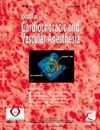Association Between Pulmonary Artery Pulsatility Index and Radial Artery Pulse Pressure and Successful Separation from Peripheral Veno-Arterial Extracorporeal Membrane Oxygenation: A French Single-Center Retrospective Study From 2017 to 2021
IF 2.3
4区 医学
Q2 ANESTHESIOLOGY
Journal of cardiothoracic and vascular anesthesia
Pub Date : 2025-02-01
DOI:10.1053/j.jvca.2024.11.013
引用次数: 0
Abstract
Objective
Few reliable tools exist to predict weaning patient outcomes from venoarterial extracorporeal membrane oxygenation (ECMO; VA-ECMO). Pulmonary artery pulse pressure indexed on right atrial pressure (PAPi) reflects the ventricle-pulmonary coupling and may be representative of right ventricular recovery. Radial artery pulse pressure (rPP) may be representative of left ventricular recovery. We intended to explore the usefulness of these indices in the weaning from VA-ECMO.
Design
Retrospective cohort study.
Setting
Single center in a tertiary university hospital.
Participants
Patients benefiting from a VA-ECMO for all-cause refractory cardiogenic shock between 2017 and 2021. Non-inclusion criteria were minor/pregnant patients and ECMO within 48 hours. Univariate and multivariate logistic regression analyses explored the relationship between PAPi and rPP with weaning success.
Interventions
We explored the association between the pulmonary artery pulse pressure indexed on PAPi, rPP, and the success of weaning from VA-ECMO.
Measurements and Main Results
We included 124 patients for rPP analysis and 82 patients for PAPi analysis. Higher rPP and PAPi (50.43 v 26.3 mmHg, p < 0.001: 1.78 v 0.88, p < 0.001, respectively) and shorter ECMO duration were associated with weaning success. Areas under ROC for rPP and PAPi were 0.85 and 0.88. The combination of rPP ≥ 40 mmHg and PAPi ≥ 1.09 predicted weaning with a sensitivity of 0.94, specificity of 1.00, positive predictive value of 1.00, and negative predictive value of 0.84.
Conclusion
Higher PAPi and rPP were predictors of successful weaning from VA-ECMO in this retrospective study.
肺动脉脉搏指数和桡动脉脉压与外周静脉-动脉体外膜氧合成功分离的关系:2017年至2021年法国单中心回顾性研究
目的:目前很少有可靠的工具来预测静脉动脉体外膜氧合(ECMO;VA-ECMO)。肺动脉脉压右房压(PAPi)反映心室-肺耦合,可能是右心室恢复的代表。桡动脉脉压(rPP)可能是左心室恢复的代表。我们打算探讨这些指标在VA-ECMO断奶中的实用性。设计:回顾性队列研究。环境:三级大学医院的单中心。参与者:2017年至2021年间接受VA-ECMO治疗全因难治性心源性休克的患者。未纳入标准为未成年/孕妇患者和48小时内ECMO。单因素和多因素logistic回归分析探讨了PAPi和rPP与断奶成功率的关系。干预措施:我们探讨了PAPi、rPP指标肺动脉脉压与VA-ECMO成功脱机之间的关系。测量和主要结果:我们纳入124例患者进行rPP分析,82例患者进行PAPi分析。较高的rPP和PAPi(分别为50.43 v 26.3 mmHg, p < 0.001: 1.78 v 0.88, p < 0.001)和较短的ECMO持续时间与脱机成功相关。rPP和PAPi的ROC下面积分别为0.85和0.88。rPP≥40 mmHg和PAPi≥1.09联合预测断奶的敏感性为0.94,特异性为1.00,阳性预测值为1.00,阴性预测值为0.84。结论:在本回顾性研究中,较高的PAPi和rPP是VA-ECMO成功脱机的预测因素。
本文章由计算机程序翻译,如有差异,请以英文原文为准。
求助全文
约1分钟内获得全文
求助全文
来源期刊
CiteScore
4.80
自引率
17.90%
发文量
606
审稿时长
37 days
期刊介绍:
The Journal of Cardiothoracic and Vascular Anesthesia is primarily aimed at anesthesiologists who deal with patients undergoing cardiac, thoracic or vascular surgical procedures. JCVA features a multidisciplinary approach, with contributions from cardiac, vascular and thoracic surgeons, cardiologists, and other related specialists. Emphasis is placed on rapid publication of clinically relevant material.

 求助内容:
求助内容: 应助结果提醒方式:
应助结果提醒方式:


